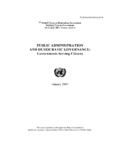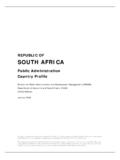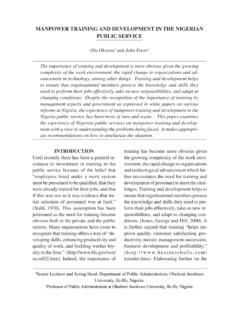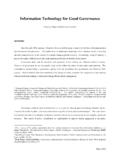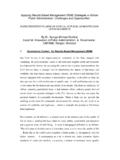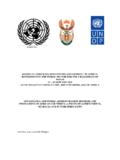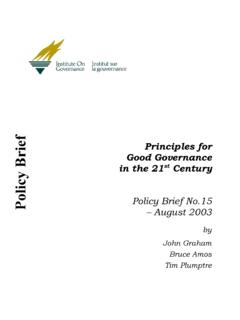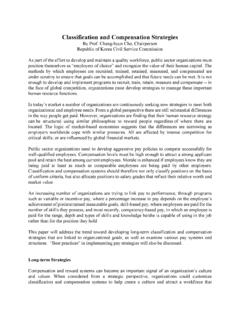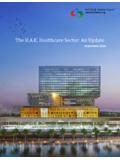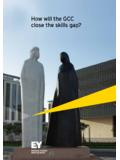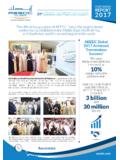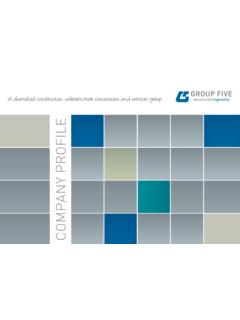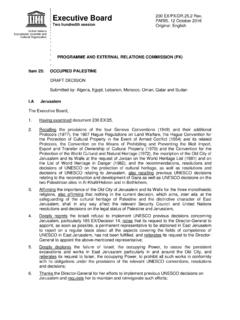Transcription of Arab Social Media Report: Civil Movements: The Impact of ...
1 Vol. 1, No. 2 May 2011. The Arab Social Media report aims to Civil Movements: The Impact of Facebook and inform a better understanding of the Impact of Social Media on development Twitter and growth in the Arab region by exploring the following questions: What are the penetration trends of Social networking services in the Arab Overview region? Until recently, experts theorized about the promises of Social networking What is the growth rate, and what technologies, including their ability to influence a participatory governance is the demographic and gender model, grassroots civic engagement, new Social dynamics, inclusive societies breakdown?
2 And new opportunities for businesses and entrepreneurs. A few months into 2011, there is more evidence suggesting that some of these promises What factors affect the adoption can prove realistic. Today, Social Media tools have merged online and offline of these platforms in different identities, while playing an arguably critical role in dramatic changes sweeping Arab countries ( , income, youth the Arab region. Governments and businesses alike have taken notice of the population, digital access, Internet potential offered by the increased penetration of Social networking tools in freedom, etc.)
3 ? the Arab region, and new trends in governance and business are emerging. Facebook continues to be the most popular Social networking tool in the Arab What is the Impact of these region, and the inaugural Arab Social Media report focused on Facebook usage phenomena on citizen engagement as the primary metric of Social Media usage in the Arab region. In this second and Social inclusion? What is the edition of the report , in addition to Facebook our research expands to Twitter, Impact of the new Social networking another Social networking platform which has been influential on several levels dynamics on innovation and during the first quarter of the year.
4 Entrepreneurship? Produced by the Dubai School of Government's Governance and Innovation Ultimately, we hope that the report Program, the second Arab Social Media report highlights and specifically findings shed light on the role that Social analyzes usage trends of online Social networking across the Arab region Media played during the Civil movements based on data collected in the first quarter of 2011. In this edition, the in the region in 2011. report analyzes data on Twitter and Facebook users in all 22 Arab countries, in addition to Iran, Israel and Turkey, highlighting the role they played in the Civil movements that swept the region during that period.
5 This is part of a larger research initiative focusing on Social engagement through ICT. for better policy in Arab states, which explores the use of Social networking This report , along with updated services in governance, Social inclusion and entrepreneurship promotion. information, charts and links to Social The initiative also studies the potential of Social networking applications networking ASMR group pages are for increasing collaboration, knowledge sharing and innovation, both available at: between and among government entities, citizens and the private sector.
6 For questions or Media enquiries please 1. Introduction direct emails to the authors at: Social Media tools have continued to grow in popularity throughout the first quarter of 2011. Facebook and Twitter, for example, have expanded their user base and platforms significantly. Facebook has over 677 million users as of April (with the Middle East constituting one of the regions that Facebook has over 677 million users as of April (with the Middle East constituting one of the regions that contributed the largest amount of new users) . Its mobile users have exceeded 250 million subscribers.)
7 Twitter users also exceeded 200. million users at the end of March. Collectively, these 200 million users tweet about 4 billion tweets a month. contributed the largest amount of new users)1. Its mobile users have exceeded 250 million2 subscribers. Twitter users also exceeded 200 million users at the end of Collectively, these 200 million users tweet about 4 billion tweets a The first three months of 2011 saw what can only be termed a substantial shift in the Arab world's usage of Social Media towards online Social and Civil mobilization online, whether by citizens to organize demonstrations (both pro- and anti- government)
8 , disseminate information within their networks, and raise awareness of ongoing events locally and globally or by governments, in some cases to engage with citizens and encourage their participation in government processes, while in other cases to block access to websites and monitor and control information on these Figures 1, 2 and 36 illustrate the Internet blackouts in several Arab countries during first quarter of Egypt's blackout lasted for five days, from January 28 February 2. Meanwhile, Libya - at the time of accessing the site (April 20, 2011) - still seemed to be suffering from low Internet access and reduced traffic.
9 Conversely, in the case of Syria, with the lift of the ban on Social Media websites by the government on February 7, YouTube and other Social Media traffic increased significantly. Figure 1: Syria: Social Media Internet Traffic Before and After Lifting the Ban on Social Media (February 7, 2011) - YouTube as an example8. 80. 70. 60. 50. 40. 30. 20. 10. 0. Jan 23 Jan 30 Feb 06 Feb 13 Feb 20. 1. edition/?utm_source=feedburner&utm_mediu m=feed&utm_campaign=Feed%3A+InsideFacebo ok+%28 Inside+Facebook%29. 2. medium=feed&utm_campaign=Feed%3A+InsideF acebook+%28 Inside+Facebook%29.
10 3. 4. 5. 6. The traffic graphs show the fraction of the worldwide traffic to a given Google product that comes from a given region. The data are then normalized and scaled so that the highest value in the graph is 100. 7. as gauged by Google's Internet traffic report 8. Source (Accessed April 10, 2011): 2 Arab Social Media report Vol. 1, No. 2. Figure 2: Libya: Internet Traffic Before and After March 3, 2011. - Sample of all Google Products9. 40. 30. 20. 10. 0. Feb 20 Feb 27 Mar 6 Mar 13. Figure 3: Egypt: Internet Traffic Between January 28 and February 2, 2011.
